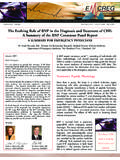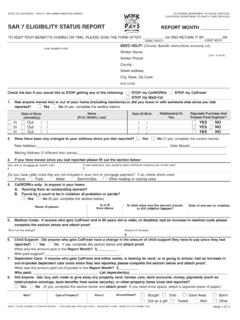Transcription of LACTATE – A MARKER FOR SEPSIS AND TRAUMA
1 LACTATE A MARKER FOR SEPSIS AND TRAUMA . Andra L. Blomkalns, MD. Assistant Professor; Vice Chairman-Education; Residency Program Director, Department of Emergency Medicine, University of Cincinnati College of Medicine, Cincinnati, OH, Director of CME and Enduring Materials, EMCREG-International OBJECTIVES: 1) Describe the process by which LACTATE would become elevated for a given patient. 2) List conditions which may cause elevated serum LACTATE other than TRAUMA and SEPSIS . 3) Explain the signi cance of LACTATE clearance.. 4) Discuss the potential uses for LACTATE in the emergency department. INTRODUCTION. It seems that each month, our journals of lactic acidosis as we know it ,2. publish the ndings of a new study which The clinical and physiologic condition of describes the use of a certain MARKER or set metabolic acidosis has been recognized of markers for the diagnosis, prognosis, for nearly a century, yet we are only or treatment of some emergency medical now discovering new approaches for its condition.
2 Manuscripts and symposia diagnosis and treatment. discussing MARKER clearance, MARKER change, MARKER panels, and point- Biochemistry of LACTATE : of-care markers reside in every issue Production and Lactic Acidosis Rather than thinking and every meeting. In this newsletter, Understanding how LACTATE levels might LACTATE , a serum MARKER older than any be used in clinical practice requires an of LACTATE solely as a cardiac MARKER cousin, assumes center understanding of how the body produces byproduct of inadequate stage in two of the most dif cult and and clears LACTATE . In a normal steady blood perfusion, it may resource intensive emergency medicine state with adequate tissue resources and conditions SEPSIS and TRAUMA . This oxygenation, more cellular energy can be useful to consider EMCREG-International newsletter aims be extracted aerobically by means of LACTATE as a MARKER to familiarize the emergency physician the citric acid cycle and the electron- with LACTATE and its potential use the transport chain.
3 In this case, cells convert of strained cellular emergency department (ED). pyruvate to acetyl CoA through oxidative metabolism. decarboxylation. Lactic acid or LACTATE , as its name implies, was rst isolated from sour milk in the Pyruvate + NAD+ + CoA Acetyl CoA + CO2 + NADH. 18th century. In 1918, scientists observed cases in which metabolic acidosis was In contrast, when the body experiences associated with decreased blood ow inadequate tissue perfusion, it undergoes and shock. In the 1970's and 80's, the anaerobic metabolism to create some seminal works of Huckabee and Cohen energy, even in a small amount. In this nally described the clinical syndrome case, pyruvate metabolizes to LACTATE 43. ADVANCING THE STANDARD OF CARE: Cardiovascular and Neurovascular Emergencies ultimately generating fewer ATPs (2 vs.)
4 36) than through In select rare metabolic conditions, LACTATE increases due the normal, aerobic mechanism (Figure 1). to inadequate oxygen utilization rather than inadequate oxygen supply. The astute clinician should factor these potential causes into the assessment of any patient with a O O. NADH. + H+ NAD+ C lactic acidosis. O. +2 ATP. O. HO C H. Rather than thinking of LACTATE solely as a byproduct of O. LACTATE inadequate blood perfusion, it may be useful to consider dehydrogenase LACTATE as a MARKER of strained cellular metabolism. For CH3 CH3. Pyruvate LACTATE the purposes of the ED patients with SEPSIS or TRAUMA , volume depletion, blood loss, septic shock, and systemic Figure 1. Anaerobic metabolism and production of in ammatory syndrome can alter LACTATE levels. Knowing LACTATE . these levels, particularly early in the patient's presentation, can provide valuable information to help guide patient assessment and treatment.
5 LACTATE production occurs in all tissues, namely skeletal muscle, brain, red blood cells, and kidneys. Even at LACTATE in TRAUMA baseline, under normal healthy oxygen rich conditions, this process occurs to some degree. LACTATE in normal Several studies show the utility of LACTATE measurements human subjects clears very quickly at a rate up to 320 in critically ill TRAUMA patients. For instance, Abramson mmol/L/hr, mostly by liver metabolism and re-conversion et al. prospectively evaluated 76 consecutive multi- TRAUMA of LACTATE back to pyruvate. This action keeps basal patients admitted to the ICU and measured serial lactates levels of LACTATE below one mmol/L in both arterial and and LACTATE clearance over 48 hours. All of the 27 patients venous in whom LACTATE normalized (to 2 mmol/L) in 24 hours survived, and only three of the 22 ( ) of patients who Heavy exercise, seizures, and shivering are examples of did not clear their LACTATE by 48 hours lived.
6 The authors common conditions which can also cause lactic acidosis concluded that the time needed to normalize LACTATE levels (Table 1).3 In these cases, the body clears LACTATE quickly could be used as a prognostic indicator in severely injured and signi cant serum increases generally do not occur. Table 1. Causes of Lactic Acidosis Inadequate oxygen delivery Disproportionate oxygen demands Inadequate oxygen utilization Volume depletion or profound dehydration Hyperthermia Systemic in ammatory response syndrome Signi cant blood loss Shivering Diabetes mellitus Septic shock Seizures Total parenteral nutrition Profound anemia Strenuous exercise Thiamine de ciency Severe hypoxemia HIV infection Prolonged carbon monoxide exposure Drugs such as metformin, salicylate, antiretroviral TRAUMA agents, isoniazid, propofol, cyanide 44.
7 LACTATE A MARKER FOR SEPSIS AND TRAUMA . Emergency physicians and emergency the authors call occult hypoperfusion.. medical service providers pay much Of the patients that corrected their LACTATE attention to the golden hour critical and occult hypoperfusion within 24. time period in TRAUMA resuscitation. In his hours, all survived. The longer it took manuscript on the importance of 24-hour for LACTATE to clear, the higher the rate of LACTATE clearance, Dr. Blow and colleagues multi-system organ failure and mortality. extend the critical period of a golden It was found that 43% of the patients died hour to a new LACTATE driven adage if LACTATE clearance took more than 24. of the silver day. This retrospective hours (Figure 2).5. observational study followed by a prospective trial included TRAUMA patients If one can conclude that LACTATE levels in In his manuscript presenting to a Level I TRAUMA center who TRAUMA patients are prognostic and that survived greater than 24 hours and had an rapid LACTATE normalization bene ts TRAUMA on the importance Injury Severity Score (ISS) greater than patients, then rapid assessment of LACTATE of 24-hour LACTATE 20.
8 Arrival and subsequent serial serum levels becomes desirable. To support this lactates were obtained and levels and conclusion, Asimos et al. conducted a clearance, Dr. Blow time of LACTATE clearance measured. These before-and-after study of implementation and colleagues patients (n=85) underwent aggressive of a point-of-care testing platform for resuscitation to clear LACTATE to a level less major TRAUMA patients. Routine TRAUMA extend the critical than mmol/L and thereby treating what labs included hemoglobin, sodium, period of a golden hour to a new LACTATE driven adage 100. 100 100 100 of the silver day.. Morbidity and Survival (%). 80. 60 57. 50. 43. 40 36. 21. 20 16. 9. 0 0. 0. 0-6 Hours 7-12 Hours 13-24 Hours >24 Hours Figure 2. Morbidity and Time to correct occult hypoperfusion survival vs. time to correct occult Reprinted with = Survival permission from Blow et al.
9 J. = Multi-system organ failure TRAUMA 1999; 47:964-9. = Respiratory complications 45. ADVANCING THE STANDARD OF CARE: Cardiovascular and Neurovascular Emergencies glucose , potassium, chloride, blood urea nitrogen, As we know, the acquisition of speci cally arterial pH, PCO2, PO2, HCO3, base de cit, and LACTATE . Only LACTATE , despite its demonstrated utility, limits its hemoglobin, glucose , blood gas, and LACTATE resulted usefulness in the undifferentiated patient population in emergency appropriate management of the ED. Without an arterial line, arterial blood gas acquisition requires the special skills of a physician, nurse, or respiratory therapist. Patients nd this Myths and Misconceptions Regarding procedure more painful and frequently refuse repeated LACTATE Measurement in TRAUMA Patients attempts or serial sampling.
10 Arterial punctures can also cause greater complications of bleeding, hematoma, I. You need to use arterial blood to measure and arterio-venous stulas. LACTATE .. Several studies nd serial LACTATE measurements to be In this study, patients arriving to a TRAUMA center useful in TRAUMA patient care. Initial ICU investigations (n=375) had both arterial and venous lactates used only arterial LACTATE and some of the more current performed within 10 minutes. Collected data included literature does not indicate whether arterial or venous injury mechanism, demographics, admission vital blood was used in the study population. Previous signs, disposition, length of stay, hospital outcomes experience and clinical use of LACTATE in the ICU setting and injury severity score. The mean arterial LACTATE suggests that only arterial LACTATE is useful.






